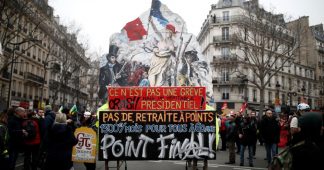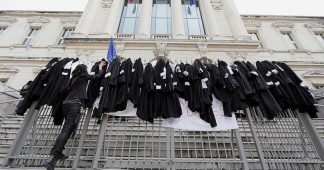Jan 16, 2020
For three weeks now, France has been experiencing a very large-scale strike movement. If this strike is so strong, it is because it does not just draw on the classic repertoire of social mobilization. The strike movement builds on a year of incredible struggle on the part of the Yellow Vests. But it also draws on the radicalism of the movements in 2016 and 2017 against the new employment laws, and on the struggles of railway workers and students in 2018–struggles whose failures are perhaps being overcome, with some of their successes finally consolidated. As one Paris transport striker rightly pointed out during a general assembly at Saint-Lazare station:
It’s not 1995 or anything else that’s the reference, it’s 2019!
By condensing a multitude of revolts, this movement has given new life to a variety of practices and slogans that have grown stronger by the day rather than being limited to one offensive per week or per month. The struggle is ongoing, and much still remains to be imagined and built. But in a European context in crisis, we should underline the broad issues that the French case raises, one by one, in terms of generating counter-powers to neo-liberal and authoritarian policies. This is the stake in this confrontation, which is increasingly taking on a historical scope, going far beyond the national framework.
Against the pension reform and its context
In France, although the welfare state has come under increasing attack, social struggles have so far managed to slow down the neo-liberalization process, with only 2 per cent of the population covered by private pension schemes. In the rest of the Western world, and especially in the English-speaking countries, pension funds have built up a substantial capitalization as complementary insurance.(2) It is therefore understandable why the architect of the current reform is such a character as Jean Paul Delevoye, a ‘senior’ civil servant whose multiple mandates and five-figure salaries caused such a scandal that he had to resign. He was receiving payments from the same insurance companies that were eagerly awaiting the opening of the very profitable and underdeveloped market presented by our old age. This is a typical example of the structural nature of corruption in the age of authoritarian neo-liberalism.
This reform aims in fact to destroy a pension system based–for all its limitations–on the principle of intergenerational and inter-occupational solidarity. It is a systemic reform, the transition from a compensatory to a contributory system, as well as a parametric reform that introduces a ‘pivot age’(3) and lengthening the contribution period. Anti-social as they were, the other reforms implemented since 1993 had not changed the foundations of the pension system. On the pretext of simplifying the current system, the monster Macron has produced seeks to erase the defined benefit system (with the legal guarantee of a certain percentage of salary or occupational income) and replace it with a system where only the contributions payable remain defined (with no exact knowledge what the actual level of the pension will be, given the fluctuating value of points built up).
Until now, the pension system has been the subject of a political debate around the share of the wealth produced by society that is allocated to pensions. The debate thus focused on the alternative between increasing contributions or retirement age, as well on the question of equal living standards during working life and after retirement. The points system will make it possible to expunge this political debate, proposing instead a purely economic and budgetary management of the pension system. This volatility is a fundamental political point: profoundly anti-democratic, it creates total uncertainty about the rights that each person will enjoy in retirement, making these dependent on the goodwill of state technocrats.
As if that were not enough, Macron decided to go for broke, proposing at the same time a change in the calculation of pensions. At the moment, most pensions are calculated on the basis of the best 25 years of working life, thus smoothing out (a bit) difficult times, odd jobs, unemployment or part-time work. With the reform, however, the entire working life will be taken into account. According to various estimates, people will lose 10, 20 or even 30 per cent and more of their monthly pension. Especially for women and those in precarious work, this is a real massacre. If we add to that the extension of working years, it is clear that the question of pensions is a real matter of life and death. With a ‘pivot age’ of 64, those who have not worked without a break, for whatever reason, will have to continue until the age of 65, 66, 67 in order to receive proper pensions. Except that 67 years, today, is the average healthy life expectancy of a male worker!
This pension reform thus follows in the wake of the laws that have eroded the French social model since the start of the Macron presidency: two successive employment laws, reform of the baccalaureate, university selection (ParcourSup), reduction of housing benefit, unemployment reform, etc. All these transformations form a coherent system, a punitive system that aims to reconfigure the institutions of the welfare state in an authoritarian and private-oriented direction. The primary political objective of these arrangements is to further discipline the stages of life by the introduction of reward and punishment mechanisms, to deteriorate working conditions still more, and to permanently undermine workers’ margins of negotiation. In other words, like the austerity reforms introduced in other national contexts (Greece, Italy, Spain, etc.), the object is to make the modalities of entry into, remaining in and exit from the labour market more flexible in order to better govern the entire cycle of social reproduction. These are therefore fundamental issues, which require a large-scale movement in response.
Reinvention of the strike and mass ‘yellow-vest’-ification
The scale of the strike that began on 5 December was historic, both in the public and the private sectors. The same amplitude, or still more depending on the sector, as that of the movement of 1995 which caused Juppé to withdraw his plan to extend the duration of pension contributions. However, the social and political situation today is quite different. After three heavy defeats (the employment laws of 2016 and 2017, then the railway action in 2018), the trade-union movement no longer seemed able to achieve major victories outside the restricted framework of individual companies. The Yellow Vests uprising, as unexpected as it was powerful, gave the impression of turning the tide, particularly with its radical criticism of organized leaderships, but it seemed to be weakening after a year of continuous struggle. Now, instead of both sides running out of steam, we have seen a revival of struggle, combining traditional forms of the labour movement with a ‘yellow’ effect of offensiveness, creativity and openness to new themes of struggle, the whole constructed on a basis of self-organization and a redefinition of ways of being together and of militancy. A great movement of direct democracy that has not escaped the mainstream media themselves, which have begun to speak of the ‘yellow vest-ification of the conflict’.
The strike figures are impressive. No other national context in Europe shows such readiness to stop work and protest against neoliberal crisis management. RATP and SNCF employees,(4) joining together across union federations, have been sitting on their hands for three weeks, continuing their action during the Christmas holidays. Strikers in these two key and combative sectors are currently causing a real metropolitan blockage in Ile-de-France and a considerable slowdown in traffic everywhere else. Strikes in the energy sector are also very strong: electricity, oil and nuclear power. In these strategic sectors, the strike call has been very largely followed: 80 per cent in some nuclear power plants, 44 per cent of EDF staff, and seven out of eight refineries blockaded, as well as 12 oil depots. Several large petrochemical plants have also been shut down, such as Lavéra, where a renewable strike was voted by more than 80 per cent. The strike on 5 December was also strong in air transport (30 per cent of flights cancelled), education (around 75 per cent throughout France), the civil service (around 32 per cent) and the hospital sector (16 per cent). There was also a large presence of fire-fighters, whose firecrackers set the rhythm of the marches. This dynamic has lasted for three weeks and could be revived again after the holiday season.
The figures for demonstrations are also impressive: more than 250 throughout France, with 1.5 million people mobilized on 5 December and 1.8 million on 17 December, to which must be added other more modest but equally significant demonstrations on other days. In these processions–animated by full-time and precarious workers, unemployed, as well as university and school students, Yellow Vests, environmental and feminist groups–union chants and demands mixed with those of the Yellow Vests: from ‘Macron resign’ to ‘Revolution! Revolution!’, the uprising of 17 November 2018 has now affected imaginaries of conflict among large sections of the population. Another pleasing ‘yellow’ effect, hailed by Phillipe Martinez himself,(5) is demonstrations from a few hundred to a few thousand people taking place in many small towns and villages. Motorway tollbooths have also been blockaded, and roundabouts occupied or reoccupied in different places.
These two big days of demonstrations were articulated with the Saturday actions of the Yellow Vests and sometimes supported by trade-union rank and file. We saw this in the Yellow Vests ‘Action 59’, dedicated to a ‘general rallying’. Their last action of the year began in front of the Paris Stock Exchange. Since the beginning of the strike, rank-and-file trade unionists have been involved in the Saturday actions, but 28 December was a real joining together: Yellow Vests from all over France answered the call of the strikers, who did not grant Macron any truce during the festive season. The choice of this date built on the tactical intelligence the Yellow Vests acquired during their first actions of 2018, standing up to the police while remaining mobile, particularly on the rue du Renard, where the atmosphere of barricades in a popular festive atmosphere recalled the insurrectional climate of the previous December.
The ‘yellow’ effect in the strike movement, therefore, is not just a matter of inventiveness and encounters, but also and above all of extending the struggle and its temporality to those who were not struggling or no longer struggling. From this point of view, the Saturday mobilizations should perhaps be reinforced and amplified, the choice of the weekend being a fantastic vector of mass politicization of those for whom organizing at work is difficult, even inconceivable, especially since the wage losses of a long strike are unbearable for many people. In this respect also, the convergence of the current strike movement with the most atomized workers is yet to be built, because it has become increasingly hard to go on strike in start-ups, in sectors where precarious employment is the rule, or in companies where bosses rule with a completely free hand.
Amplifying the strike: extending the repertoire of action
In support of the strike and to amplify its already massive effect, an incredible myriad of blockading actions have been deployed throughout the country, at unprecedented levels of intensity. A large number of distribution centres have been blockaded, most major ports have experienced large-scale disruption, factories have been temporarily put out of action, and more or less strict blockades have proliferated on ring roads, bypasses and roundabouts and at tollbooths. Many universities and an impressive number of high schools have also been blockaded from the very first days of the movement. Taking inspiration from the environmental movement, Yellow Vests and/or trade unionists have invaded large shopping malls, symbols par excellence of productive consumption and capitalism’s new logics of exploitation. In the Ile-de-France region, the RATP bus stations–whose employees are more precarious and find it harder to mobilize–were the focus of a fierce battle every morning at dawn, gathering several hundred supporters spread over seven or eight depot blockades.
These strategic nodes for halting the production and circulation of goods have been regular meeting places for teachers, hospital workers, precariously employed and unemployed, as well as university and high-school students, ecologists and Yellow Vests (with or without vest). Each day of mobilization, around a fire of pallets and a coffee, there is thus a real refusal to sectoralize the struggle. Proof that a strategic issue is involved is that repression has also intensified on these picket lines and clashes now begin as early as 5 am. Using tear gas and truncheons–also rubber bullets at high schools–the police have tried without success to break the strikers’ determination. It is a rare occurrence in the history of social movements, but reminiscent of the recent history of the Yellow Vests, that this process fuelled from the bottom up, and based on the principle of horizontality, has not been suspended during the Christmas holidays.
While the repertoire of action has expanded on an unprecedented scale, the forms of direct action have also gone beyond the usual contours, demonstrating the strikers’ offensive potential. At EDF, for example, the mobilization committees caused a considerable number of power cuts at strategic points such as Amazon warehouses, town halls and prefectures. On 25 December, hundreds of thousands of households (half a million in the Ile-de-France region) were able to take advantage of an unofficial cut in electricity tariffs. The group Extinction Rebellion sabotaged thousands of rental electric scooters, seen as strike-breaking machines, highly polluting and recharged by sub-proletarians. Outside Rennes, employees of the Remade company, which was threatening to close its doors, responded by starting to crush thousands of iPhones awaiting reconditioning. In Paris, demonstrations were called by rank-and-file SNCF and RATP workers, outside the official federations, with station invasions and blockades of automated Métro lines. An extension of the repertoire of action that in a way recalls the processes observed during the great strikes of 1936 and 1968.
There is also a breakdown of sector boundaries in the setting up of strike funds and their democratic self-management. This can be seen as a new form of the mutual-aid dimension characteristic of the wartime resistance councils that gave rise to the modern social security system. These funds make possible not only a long-term anchoring of the movement, but also keep the strike in the hands of the strikers themselves. This year’s ideal Christmas present would therefore be a donation to one of the many inter-sectorial strike funds great or small. And for New Year’s Eve (renamed ‘G-Réveillon’),(6) many support parties have already been organized, since you can’t make revolution without dancing. Like the local assemblies, these strike funds increasingly go beyond corporatist limits, establishing a form of counter-power that is autonomous from the trade-union federations and head offices.
Despite traditional trade-union organizations no longer being as strong as in 1995, the creativity and multiplicity of struggle practices implemented in recent weeks testify to a real reinvention of the strike weapon in the face of the challenges of contemporary capitalism. A reinvention spurred by the dissemination of the logic and practices of action of the Yellow Vests, attacking the nodes of circulation and reproduction of society and expressing an antagonism inseparable from autonomous and horizontal forms of organization.
Renewable self-organization
If this strike has been able to assume this particular aspect, it is also because of the forms of self-organization on which it is based. During these three weeks, the strikers themselves took control of the movement, collectively deciding its power and form. Inter-occupational general assemblies flourished throughout the country, under the impetus of the most mobilized sectors but open to all strikers, Yellow Vests and other components. In many cases, these general assemblies became true local assemblies, even district assemblies where discussions go well beyond the framework of pension reform. As was the case with the Yellow Vests, proximity–spatial and emotional–has proved to be an inescapable and decisive dimension.
By frequently spanning socio-occupational categories, but also because the massive transport strike has reconfigured the metropolitan area, those mobilized have met at a local level, in neighbourhoods and districts, encountering each other every day, constantly exchanging and initiating actions of different kinds, practising direct democracy on a daily basis. These assemblies raise the question of connections between sectors, connections between themes of struggle, and ultimately the social connection as a whole. To put it another way, they raise democratic issues, with the overthrow of the hated Macron regime in mind even if this is not always formulated.
The theme of pensions is too narrow to contain all the anger, but it is a good basis for widening the framework of discussions in general assemblies. The issue of women’s pensions is particularly a major issue, and the feminist movement a force to be reckoned with. The massive mobilizations against gender-based violence on 23 November triggered a wave that is already permeating the pension movement, as shown by the Chilean chant heard at the front of marches: ‘el estado opresor es un macho violador’ [the oppressor state is a macho rapist]. On this point in particular, the speech by prime minister Édouard Philippe was a real declaration of war.(7) Another battlefront that could engage the demonstrators is ecology and its many ramifications.
In recent weeks, several groups have taken a particular stand on pension reform to underline the fundamental links between the productivist model, the extension of working hours and the loss of leisure time. In short: the possible strengthening of these dynamics points to an explosive start to the New Year.
The strength of these assemblies has also given a new aspect to the head of demonstrations, with less offensive practices but a more heterogeneous and much more massive composition. At the head of these processions of tens of thousands of demonstrators we see people from all fronts of the struggle (students, teachers, hospital workers, railwaymen and -women, fire-fighters, the world of culture, etc.). And if this composition is far broader than that of the Saturday events of the Yellow Vests, it takes up some of their words and practices of struggle, which is their true heritage and most precious legacy.
The proliferation of handmade banners with original slogans is one example among others of practices that circumvent the domination of trade-union placards. On the education front, each high school or college comes with its own banner brandishing the name of the particular establishment. From the RATP, several Métro lines also have their own banners, which gives full meaning to their presence in an autonomous procession. What was once a part–even an impressive part–of the procession has now become the entire event. One might say that the ‘head of the procession’ has become its heart as well. With tens of thousands of people outgrowing the classic framework of demonstration, the question that now arises is that of a reconquest of more incisive demonstration routes, even going beyond the route-form itself, seeking out political leaders in their places of power and the upscale neighbourhoods of the capital.
We find here, as with the blockades, a determination that goes beyond the classic modalities of social mobilization and the trade-union federations that perpetuate these. And if this dynamic was already in preparation for several months, as shown by the victorious strike of the railway workers at Chatillon, or the struggles of the hospital sector and fire brigades, it now constitutes the basic political grammar of any mobilization. So far, the renewal and generalization of the strike have clearly been based on the spirit of autonomy and capacity for initiative that has emerged in France since 2016, and which saw a real leap forward with the Yellow Vests.
The Macron regime in retreat
The Macron government’s hope for a way out was that tiny adjustments to the reform would lead the trade-union front to fracture. But for the time being, and quite surprisingly, things are not going according to plan. In UNSA, a large part of the union rank-and-file remain deaf to calls for a truce, and even the CFDT has not given up after the first round of negotiations.(8)
A question that has been raised since the beginning of the political phase opened in 2016 is the profound change in the role of the trade unions, the intention of the new employment laws being to return these institutions to a function of sectorial negotiation, even negotiation within individual companies, while the rank-and-file have grown increasingly independent from the federal leaderships and undertaken ever more offensive forms of struggle. In spite of the role played so far by the union leaderships, the current sequence confirms this trend. It was in fact the strikers themselves, in several hotbeds of struggle, who took the political initiative in this movement, extending and intensifying the economic blockades. The CFDT’s continued adherence to the union front, following the provocative statements of Édouard Phillipe,(9) is a good sign of the contradictions in the world of labour and its organizations: on the one hand the existence of a mass social movement that is autonomous from the organs of official representation; on the other hand, a government that fiercely resists any kind of social mediation.
The union federations thus find themselves caught between the hammer of a self-referential state and the anvil of a mass movement that has arisen on an issue as general and crucial as pensions, consequently involving broad strata of society–strata that have seen for more than a year the power of the Yellow Vests movement, but have also seen the hostility of the union federations towards this force and its implacable resolution. While rank-and-file unionists often did not wait for the Yellow Vests before taking a stand in their organizations against the logic of their leaders, the phenomenon now seems to be acquiring an unexpected scale, affecting those unions most inclined to negotiate quickly and most disciplined in their role as ‘social partner’. The movement to generalize and radicalize the strike can therefore be seen as a good opportunity for political recomposition.
In this respect, Christmas 2019 in the railway stations and on the picket lines shares the same sentiment as Christmas 2018 at the roundabouts: the resurgence of the feeling of fraternity that makes for a horizontal form of organization, autonomy and offensive strategy. This fraternity has produced a double movement of rupture and re-appropriation of festivity, interrupting the reproduction of a Christmas of commercial consumption and the state-family order, and reinventing a temporality of festive and insurgent struggle.
If at times we have continued to use the expression ‘union rank-and-file’, it seems preferable to speak more simply of strikers. For the old dialectic between rank-and-file and leadership has shifted thanks to the junction of a multiplicity of dynamics of struggle, which not only reject the very form of negotiation, but deprive it of meaning. Beyond its rhetorical use, this is the profound meaning of the slogan ‘Christmas: the strike belongs to the strikers’. As on the roundabouts the previous Christmas, during these holidays fraternity expresses itself in train stations, on picket lines and in the mutual aid of strike funds as a collective power, and as a line of demarcation between class friend and class enemy. Fraternity is source and life-blood for the determination of roundabouts and picket lines: we will go all the way.
To conclude, the pension reform has acted as a catalyst for a wide range of angers that have been expressed for several months in France and become intense again since last autumn. This dynamic of expanding protests against Macron and his world is now driven by a broad and transversal composition. With the strike, it has taken on a massive character that reconfigures practices of struggle and conveys very important political contents. Macron, the spearhead of authoritarian neo-liberalism in Europe, now has to deal with layers of revolts that overlap one another and could be mutually reinforcing.
In response to government rigidity, the level of struggle of the last three weeks is set to continue. Between now and the next major demonstration on 9 January, processes of self-organization could further consolidate and fuel the possibility of a large-scale uprising. In this respect, the wave of assemblies also offers an opportunity to look further ahead and perhaps imagine the movement taking firm root over time. And as the bill is expected to be presented to the council of ministers at the end of January and then to parliament at the end of February, it is quite possible that the protest will go beyond its initial aim of forcing a withdrawal of the reform, and generate unexpected perspectives.
Originally published at: www.platenqmil.com. Translation by David Fernbach
Notes
- A composite of ‘grève’ [strike] and ‘révolution’.–Trans.
- Out of a total €11,000 billion household assets in France, more than two-thirds is made up of real estate, €1,500 billion in savings accounts and life insurance, and only €130 billion in retirement savings schemes: the potential for developing the pension fund market is thus huge. For the time being, however, the point-based reform will mainly give these funds access to the highest earners. By abolishing contributions for monthly incomes above €10,000, the reform would enable institutions such as Black Rock or BNP Paris-Bas Asset Management to attract €3 billion from the 300,000 richest households in France. With this reform, France is thus preparing to do what the United States did 45 years ago with the ERISA law: the transition from a system with defined benefits to a system with defined contributions. However, one difference must be underlined: whereas the funded system makes pension value dependent on the vagaries of the financial markets (and since 2008 we know how ruinous these vagaries can turn out for many pensioners), the French reform as it stands would subordinate this to the goodwill of the government, according to the state of the public accounts. In short, pension contributions would play the role that a workforce on short-term contracts plays in a commercial enterprise: an adjustment variable for Enterprise France.
- The minimum age at which full retirement benefit will be payable.–Trans.
- Respectively the Paris region transport authority and the national rail network.–Trans.
- General secretary of the CGT, the largest and historically most militant trade-union federation.–Trans.
- A composite of grève [strike] and réveillon [New Year’s Eve].–Trans.
- On 11 December the prime minister infuriated the pension movement by his patronising words about women workers, and the offer of token concessions to housewives and widows.–Trans.
- UNSA, the fourth largest trade-union confederation, is composed largely of education unions. The CFDT, the second largest, is historically more moderate than the CGT.–Trans.
- While the CFDT is clearly opposed to the new retirement age, it has limited itself to defending those workers who benefit from a certain degree of employment security, to the detriment of those in a more risky and precarious position.
Published at https://mronline.org











